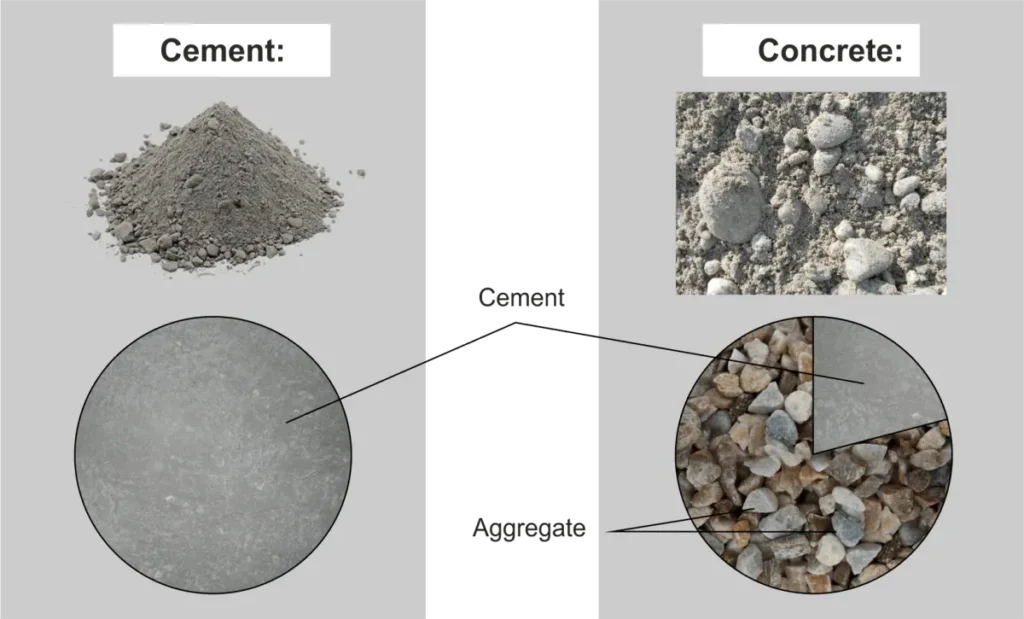
Concrete and cement—people mix them up all the time. Are they the same? Not even close! The difference between concrete and cement is bigger than you think. One builds, the other binds—simple yet misunderstood. So why does this confusion exist? Blame everyday conversations, misleading ads, and even DIY guides. The truth is fascinating, and most people never realize it. Ready to clear up the confusion once and for all? Let’s break it down and get the facts straight!
What Is Concrete?
Concrete is the world’s most used building material. It’s a tough mix of cement, sand, gravel, and water. It hardens into a solid structure once poured. Roads, bridges, and buildings rely on concrete’s strength. It can handle extreme weight and pressure. The secret? A chemical reaction called hydration. This process binds the ingredients together. Concrete is durable, long-lasting, and low-maintenance. It resists fire, water, and daily wear. That’s why it’s everywhere. Concrete holds things together from sidewalks to skyscrapers. Modern construction wouldn’t exist without it.
What Is Cement?
Cement is the binding agent in concrete. It starts as a fine powder made from limestone and clay. It forms a paste when mixed with water. This paste sticks to sand and gravel which creates concrete. Cement itself isn’t strong or durable. It needs other materials to work. It’s mainly used in construction but has other uses too. It helps make mortar for bricks and stucco for walls. There are different types of cements. Portland cement is the most common. Concrete wouldn’t exist without cement. It’s the invisible force that keeps buildings and roads standing strong.
What Is the Difference Between Concrete and Cement?
Cement and concrete are not the same thing. Concrete is the final product and cement is just an ingredient of it. Think of cement as flour and concrete as bread. You need one to make the other. Cement alone won’t build anything. It’s too weak on its own. Concrete is strong and long-lasting. It supports buildings, roads, and bridges. People often confuse them, but the difference between concrete and cement is simple. One binds, the other builds. Next time you hear someone say “cement sidewalk,” you’ll know they mean concrete. Now, you know the real difference!
How Cement Turns Into Concrete?
Cement alone is useless without other materials. It forms a sticky paste when mixed with water. This paste coats sand and gravel, binding them together. A chemical reaction called hydration starts instantly. The mixture thickens, hardens, and gains strength over time. it sets into shape within hours. Over weeks, it becomes rock-solid concrete. Temperature and moisture affect curing speed. The result? A structure that lasts decades. That’s why cement is never used alone. It’s the glue, but concrete is the real powerhouse. Without cement, concrete wouldn’t exist. cities wouldn’t stand without concrete.
Myths and Misconceptions About Cement and Concrete
Many believe cement and concrete are the same. They’re not. Cement is just one ingredient in concrete. Some think concrete dries—it actually cures through hydration. People assume concrete cracks mean poor quality. That’s wrong. All concrete cracks, but control joints manage it. Another myth? Concrete lasts forever. While durable, it still wears down. Many also think adding more water makes better concrete. It weakens the mix instead. Lastly, reinforced concrete isn’t crack-proof. It just holds together better. These myths create confusion, but now you know the facts.
Fun Facts You Probably Didn’t Know
Concrete is the most used material after water. The difference between concrete and cement confuses even experts. The Romans built concrete structures 2,000 years ago, and they still stand. The Hoover Dam contains enough concrete to last centuries. Some concrete gets stronger over time instead of weaker. Wet concrete can reach up to 200°F while curing. The world’s largest concrete pour happened in China. Concrete can float if made with lightweight materials. Even astronauts study concrete for space construction. Now, every time you see a sidewalk, you’ll think differently!
Conclusion
Cement and concrete are not the same. Cement is just an ingredient. Concrete is the final product. Cement binds, while concrete builds. Many people confuse them, but now you know the facts. Concrete is strong, durable, and essential for construction. It forms roads, bridges, and buildings worldwide. Myths often mislead people about its properties. Understanding these materials helps in making better choices. Concrete lasts for decades when made correctly. Next time you see a structure, remember the role of cement. Without it, modern construction wouldn’t exist. Now, you can confidently explain the difference between concrete and cement.
